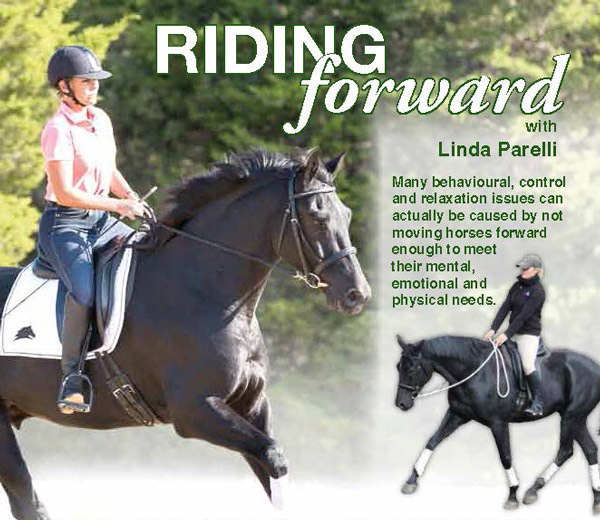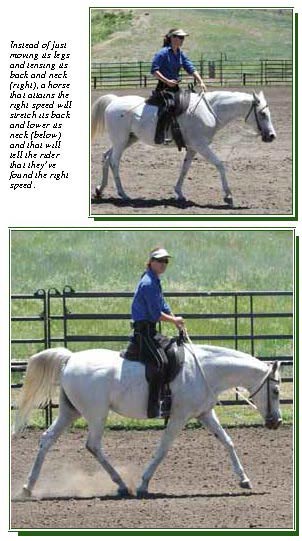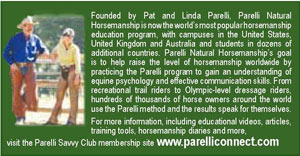|

Horses are made to move - they need to move - but often riders don’t allow their horses to move enough. Although daily exercise - in the paddock or under saddle - is a factor, that’s not the only way that horses need to move, as there’s also the speed at which they need to move within their gait. It’s important to know that many behavioural, control and relaxation issues can actually be caused by not moving horses enough to meet their mental, emotional and physical needs.
Being prey animals, horses don’t do well with being held back. Suppression makes a horse claustrophobic, tense, nervous, resistant, impulsive… it can even affect the regularity of their stride. Believe it or not, movement can be used to relax the horse, and even introverts need to move!
Don’t hold THE horse back
Unless riders need to get control and stop - which would be done with one rein, bending to a stop – they shouldn’t hold the horse back when it becomes anxious and needs to move its feet. Riding forward will quickly take the anxiousness away. A lot of riders are too tentative in this situation and it is so tempting for them to hold an impulsive horse back, but it only makes things worse because claustrophobia is then added to the problem. This impulsiveness is most likely to show up in Right-Brain Extroverts, but any horse that gets worried can go there.
When the horse wants to go, simply ride forward in a very small circle and almost a little faster than the horse wants to go. Linda Parelli says, “I think of it this way: ‘You can go as fast as you want… inside this hula-hoop.’ Okay, the hula-hoop is about 6-9 metres in diameter, but it is a small circle, so that makes it very difficult for the horse to maintain any kind of speed. And because the horse is going forward, it gets calmer… and pretty quickly too.” As soon as the horse starts to soften and slow, the rider softens and slows down also, and if the horse gets stronger, they ride stronger again. It doesn’t take long for the horse to see the goal and want to attain it. Here’s the good news: the imaginary hula-hoop can be taken anywhere the horse and rider go… the moment the horse starts getting antsy, trot forward quickly on that small circle until it is calm again.
Match the energy
Some people ride the same way no matter what the horse is doing, but the secret is to match the energy of what the horse is doing. If it is hurrying, ride stronger to match the energy but not add to it. The moment the rider matches it, the horse will become calmer. This is because disharmony is very unsettling for a horse, so when the rider mirrors them, it feels much better and makes them less emotional. It might take a little practice to figure this out, but once this happens it will come easier every time.

Thunk-Thunk
What if the horse just wants to go slowly everywhere? The worst thing the rider can do is spur and spank or keep constantly nudging with the legs. Sure, it might produce a surge of energy, but it doesn’t last and then the rider ends up nagging the horse in an effort to keep it going. Rather than being mechanical about it (spurs, sticks), use psychology - get into the horse’s mind or it will never be their idea to go forward.
Linda Parelli calls it ‘thunk-thunk’, as opposed to ‘smack-smack’ or ‘spur-spur’. The latter will just annoy the horse and result in it putting its ears back, swishing the tail or even kicking up, so a clever game is needed to get the horse thinking about what the right response would be. First squeeze lightly with the seat and thighs, and when there is no response, start tapping with a Carrot Stick (training stick or whip). But how the rider taps is critical: tap the horse on the shoulder as lightly as possible, and every three seconds, double it. So first it’s a really soft tap, then three seconds later double that, then three seconds later double that, then three seconds later double that… get the picture? What’s really important is that the taps don’t get faster as they are increased, because spanking faster brings up emotions, and that is not the aim of this exercise.
Every time the horse chooses to ignore being asked to go forward, the rider can smile and start the thunk-thunk. It’s kind of a fun game… not mean and not emotional, and best of all, the horse gets it and begins paying attention to the seat or the lightest tap, and everyone is happier. Just remember to stop the tapping the moment the horse can be felt to try to put in an effort. Pressure motivates, release teaches.
Thunk-thunk is perfect for the rider to enable them to engage the horse’s mind.
Plink-Plink
This is almost the opposite of thunk-thunk. Plink-plink is gentle and persistent, like dripping water, where a tap keeps dripping on the same place on someone’s forehead every couple of seconds and drives them crazy! It doesn’t get stronger; it just gets their attention – especially after about the 5th or 6th drip. That’s how the rider is going to encourage the horse to put in a little more effort but without bringing up the horse’s emotions. Also, unlike thunk-thunk, plink-plink is on the horse’s hip rather than its shoulder.
Let’s say the rider wants their horse to walk faster, or trot with a bit more effort. Firstly, the rider would bring a little more life up into their body and then, holding the Carrot Stick over the thigh, start tapping the side of the horse’s hip, methodically, softly, once every three seconds… without increasing the pressure. At first the horse might swish its tail like there’s a fly bugging it, but after several plinks, it’ll quicken the pace a little. The moment the horse does that, stop the plinking. After several repetitions, the horse will start to become more in tune with the rider’s seat and hold the pace or speed until the rider asks the horse to change it.
While this can work in any situation where the rider may want a little more effort without bringing up the horse’s emotions, it is the perfect strategy because it doesn’t upset the horse, and they can think their way through the rider’s request.
What speed is right for the horse?
“When I watch riders, I really tune into energy. I try to see if the rider and horse are in harmony or disharmony in terms of their energy. Say the horse is striding strong and energetically but the rider is hesitant or too relaxed, or it’s the opposite - the horse is dawdling along and the rider is using a lot more energy than the horse,” says Linda Parelli.
The first goal is to perfectly match the horse’s way of going when it starts to trot. The rider will either need to ride a little stronger with more energy, or soften up and slow down a little until they feel that harmony.
The next goal is to find the right speed, where the horse will use its whole body instead of just moving the legs but tensing its back and neck. When the right speed is attained, the horse will stretch its back and lower its neck and that will tell the rider that they’ve found the right speed.
Some horses need to move more energetically forward than may be thought, but as the rider gently keeps urging the horse forward until it lowers its neck, the horse will actually lengthen the stride and loosen its back. The tension goes and suddenly the rider has a horse that is more relaxed and mentally tuned into them. Experiment with this, put it into practice and see what is meant by this. If the horse’s head goes up when beginning the trot, slowly and gently urge it faster, little by little, and all of a sudden the neck will stretch forward and down, the back come up and the horse may even start blowing out as it releases tension. Trotting gradually faster is also something horses need for their body and balance; that’s where plink-plink can be very helpful.
Once the rider can pretty accurately guess what kind of speed is going to be needed, they will naturally learn to match the horse’s energy and find harmony, right from the start of the training session.

|